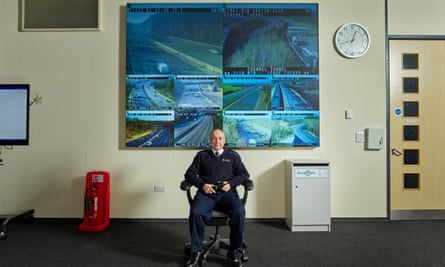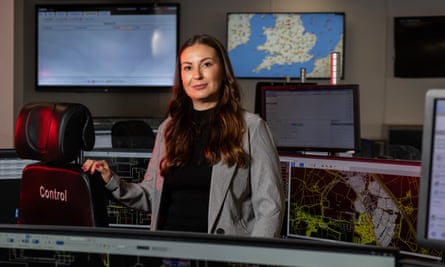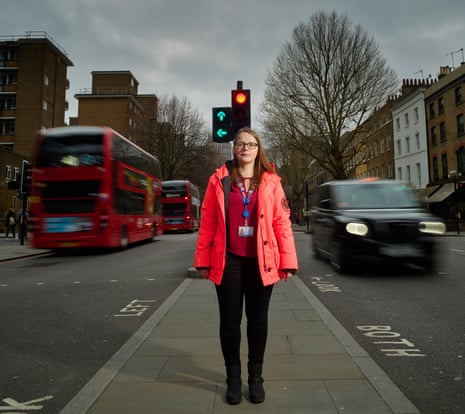‘Just Stop Oil might have superglued themselves to the road’
Katie Willis, 40, control centre duty manager, TfL, London
Roads, tunnels and buses – that’s our patch. All the everyday stuff of keeping London moving. Day-to-day operations are looked after by a huge team of people. From the control room, we’re coordinating when incidents arise. These might be roadworks, vehicle collisions, obstructions or closures that get in the way of operations. London Marathon Day is a big one, New Year’s Eve celebrations, too. Just Stop Oil might have superglued themselves to the road; a bus driver assaulted or spat at. Falling trees are a headache. Naked-person-on-bus is a surprisingly common occurrence. Whatever is happening, we take the call and make a plan.
We have all sorts of sources of information: emergency services, a massive network of cameras, a schedule of events or maintenance. But it’s bus drivers calling on their radio who are our biggest source of intel – they are our eyes and ears. If buses are running late, we can try to work out why, and act to adjust routes if needs must. We’ve got up to 8,000 buses running at any one time – that takes a lot of management from up here.
Other road users come under our remit, too. Cyclists, pedestrians, cars or scooters – we also need to keep them moving. We have our own network of roads, we call them the red routes: major streets across the capital that we run and operate ourselves. It’s our job to manage traffic on these routes day and night. Across London, we own about 6,500 traffic lights. We can manually control how and when they change to encourage traffic to head a certain way. Electronic displays on major London roads – changing speed limits, red Xs, warnings and cautions – are also controlled from here. And then there are tunnels – we have 12 in total.
The biggest challenge we’ve faced in years was Operation London Bridge, when the Queen died. We got the call and whirred into action. Our next 10 days were meticulously planned. Roads needed clearing, buses diverting, traffic managed. The queue, for instance, was an entirely unexpected challenge – we were adapting to events in real time. I work long shifts. Midweek it’s early, lates and nights in a rotating pattern. Weekends are 12-hour stretches either day or night. Plus, I have a two-hour commute each way to Northampton and a three-year-old at home waiting for me. It’s hard work, but I want to be mum and do the job, too. When my train is delayed, or I find myself on a motorway suddenly closed, I don’t get irate. With a job like mine, you appreciate what’s happening behind the scenes. Trust me, countless people are working flat out to minimise disruption.
‘We see fatalities in real time on our screens’
Sean Sloan, 54, National Highways South East Operations Centre team manager, Surrey

Our team has a single task at hand: across our network of roads, to keep as many lanes safely operational as possible. That’s no mean feat, given we’re responsible for the bottom half of the M25 and all the major connecting feed-in routes down to the south coast: the M20 to Dover, Kent’s A2/M2, M23 to Brighton, M3, M27, M271 and M275, among others.
Usually, we have a team of 12 operators monitoring our cameras and other data, too: we’ve got sensors built into our roads called Midas [Motorways Incident Detection and Automatic Signalling] that flash up to tell us when traffic is building up, or vehicles are travelling unexpectedly slowly. Reports also come in from members of the public, breakdown recovery crews, our on-road traffic officers, local authorities and the emergency services.
Once we’ve identified an incident, we make a risk assessment to work out our response. We set overhead signs and signals to reduce speeds, warn of problems or close specific lanes; if needed, we deploy our officers to help move vehicles or other blockages out of the carriageway. If we need fire, ambulance, or police we’ll liaise with them to help them get to the incident as quickly as possible. Sometimes, a whole stretch of motorway needs closing off. Gritters, resurfacing and tow trucks – all us, too.
In a job like this, no two days are the same. Recently, we had reports of a car and horse-box pulling into an emergency refuge bay, with the animals inside trying to kick the back door down. Obviously, horses running riot on the motorway would not be good news. We lowered the speed limit to 20mph, warned of animals on roads, and sent officers to slow traffic. On CCTV, we could see the owners holding the doors shut. We shut the road in both directions. Then, we had to get a vet to tranquillise the horse – escorting him as he drove the wrong way up the closed carriageway to get there as fast as possible. No situation has a formula – it’s all dynamic. Take the time we had reports of debris in the road. We sent a traffic officer to do a rolling road block – weaving through each lane to stop all vehicles behind. In essence, bringing the motorway to a standstill. He jumped out of the car, ran up the road and from the outside lane retrieved the offending blockage: a bag of 15 sex toys.
If serious injuries or worse have occurred, the police take charge of what’s then a potential crime scene. Still, sometimes our teams are first to arrive; we see fatalities play out in real time on our screens. All our team managers are trained in trauma diffusion, counselling services are available, and after a serious incident we’ll sit in a circle and have a group therapy debrief session
‘People on the phone are often in a state of stress’
Laura Davis, 34, call assessor, West Midlands Ambulance Service, Brierley Hill, Dudley

I’m first port of call for patients. Most days, my shift is 7am-5pm. Headset on and phone logged in, I hear a beep in my ear – my first caller – right away. From then, it rarely stops until I log out again. Today, 70 of us are taking calls, but there’s no slow start, or time for chitchat over coffee with colleagues. I’ve been in the job two years now. Early on, I was overwhelmed by this full-throttle kickoff to the day. Now, though, it’s second nature.
Right away, I’ll ascertain whether a patient is breathing and conscious – the reason for them phoning. Then it’s on to location. I need all this information within 60 seconds. What I ascertain determines what happens next: there’s a triage system. If needed, I pass details on to our dispatching team, or a clinical expert if I need more medical insight. If I’ve needed to give CPR advice, or someone is fitting or in cardiac arrest, I’ll stay with that caller until a paramedic team has arrived, talking them through every second.
I try to remain authoritative on every call. Those on the phone are often in a state of stress. I need to be firm and assertive to make sure they’re processing precisely what I’m saying. If they don’t trust you, the potential lifesaving guidance you’re giving won’t go in. Compassion is also important. In many cases, I’m speaking to someone at their most vulnerable. I know how formative those conversations can be. I lost my dad a few years ago and still remember with total clarity the emergency call I made the day we lost him. With every call I take, I think about how I was feeling in that moment and what I needed as support.
How to handle a call isn’t always clearcut. Yes, we get those which aren’t medical emergencies, but we also get mental health crises, loneliness, people really struggling. Often, there’s little we can offer beyond signposting to other services or passing on a number for the Samaritans. Working here has shown me just how little provision there is.
One minute, I’m at the heart of a major incident – high emotions and high stakes – and the next second, I’m disconnected. Of course, you don’t simply forget it. If a particular patient is playing on my mind, I can ask a supervisor to see how they’re faring. There’s nothing better than the satisfaction of knowing you helped save a life. And yes, hearing the opposite is a gut punch. But honestly? There’s rarely time for reflection there and then. Seconds later, my headset beeps and it’s on to the next.
‘People will brave the elements to help out others’
Will Cook, 38, maritime operations officer, Humber Coastguard, Bridlington

To most people in the UK, our work might seem peripheral, but for coastal communities we’re integral. We answer 999 emergency calls when the coastguard is requested. Often, we’re responding to leisure users: swimmers cut off by the tide, paddleboarders drifting out in the wind, casual fishers on the coast who’ve got into trouble. Where I am, in North Yorkshire, there are also plenty of clifftop trips, slips and falls, which are under our remit, too. Less frequently, we’ll deal with commercial shipping or fishing vessels far out at sea. We monitor a VHF radio 24/7 on channel 16, that’s the one for marine distress calls. If you’re way out at sea, it’s through this you’re likely to make that request for help.
We’ve got a variety of assets at our disposal: volunteer coastguard rescue teams we call out from home, and we coordinate RNLI lifeboats. If someone is cut off by the tide, it’s likely we’d turn to them. For more complex incidents, we have our own search and rescue helicopter. If the problem is a long way out to sea, we’d do an emergency broadcast to shipping. Under maritime law, if there’s a life-at-risk mayday situation any vessel in the vicinity is obliged to respond. Then, we’re asking whoever is in the area to help.
We are here every hour of every day, doing 12-hour shifts. Our nondescript white building is at the north end of Bridlington, looking out to sea. Across five screens, we have all sorts of specialist programmes to work with: our incident logging system, tide trackers, AIS feeds that show us where vessels are in the area. We have charting programmes that show us navigational hazards and weather information systems as well. I started out 12 years ago, volunteering at my local coastguard rescue team in Whitby. It might sound twee, but I wanted to contribute something. Meanwhile I worked various jobs, called out to an incident any time, day or night. But after being made redundant from my job in a brewery, I signed up to the coastguard full-time.
Usually, we’re asking volunteers to respond to emergency situations: our only full-time crew is our helicopter search and rescue teams. It’s heartwarming to know there are people up and down our coastlines – and across the ocean I sit and look out at – ready and willing to brave the elements to help out others they’ve likely never met previously and will never cross paths with again.
‘With a mouse click I send electricity another way’
Jemma Staley, 40, control room distribution engineer, National Grid, Derbyshire

My friends don’t really understand what I do: I work in the National Grid Electricity Distribution control room, managing the high-voltage electricity distribution network for the Midlands. In short, we direct electricity from its source of generation into people’s homes, guiding it from power stations through overhead lines, pylons and along underground cables, via various substations. Drawing an actual map of all that would be impossible to follow, so instead we work from what’s called a schematic diagram: a vast number of red lines representing all the pathways our electricity travels down. I can decipher what each one represents, but to anyone not on my team, our map would look like nonsense. There are other control rooms like ours spread across the country.
Imagine a road network: you can take different routes from your starting point to the same destination. Depending on what incidents lie ahead of you, you’ll likely change course. Electricity is much the same: if a section of our network stops working or is taken out of service, it’s my job to divert the flow through a different path. Our network is designed so electricity flows into your home naturally, so we only step in – generally – when things can’t function as usual. With the click of a mouse, I can open and close switches to send electricity another way.
Often, we’re stepping in when a section of our network is taken offline for maintenance. Otherwise, it’s when unexpected incidents arise. Last week, I was on a night shift, when a customer phoned in to report a road traffic accident; someone had driven into one of our poles carrying cables overhead, knocking it down. We had to locate its position, turn off any electricity passing through until an engineer could attend. We’re also looking for other routes the electricity can take to supply customers in the meantime, as fast as we can. I’ve had a driverless tractor career directly into a pylon that fed a whole town’s power. Occasionally, bad weather damages our infrastructure. Whatever has happened, an alarm starts to ring in our secure control room.
Electricity control runs in my family. My dad was also an engineer here. I did my school work experience with him. Working here wasn’t on my agenda. I studied law at university, but worked here part-time doing admin in holidays and weekends. The summer after graduation, I went full-time while looking for other jobs. I was offered the opportunity to train as an engineer. Why not, I thought. Now, 22 years later, I’m still at it.
‘For inbound aircraft, I’m the last port of call’
Kim Gough, 38, air traffic controller, NATS Swanwick, Hampshire

From the outside, our centre looks like a corporate office. Even the lobby is quite unassuming. You’d have no idea two huge, busy control rooms oversee much of England’s airspace. Each operates 24/7/365: endless screens, banks of radar with people talking at a mile a minute, but inside it’s calm and quiet, like a library. One room looks after the airspace over London up to about 24,500ft, including the major airports around the capital. The other covers much of England’s airspace above that level, from Manchester southwards. People recognise airport towers – they control aircraft on the ground, then through takeoff and landing. The rest of the time? It’s down to us. Unlike our airport colleagues, we never see the planes we’re guiding. In fact, we’ve got no windows to look out from. In our London team, 50 controllers are working most of the time – the airspace here is so complex.
Once an aircraft is established in its climb, it is transferred to us until it leaves UK airspace. We split up airspace into sectors – some can even be on top of each other – with different controllers to handle each. I do the approach function for Stansted and Luton, starting 25 to 30 miles out from the airfield. When they’re inbound, I’m their last port of call, establishing their final approach, and they’ll stay with me until seven miles from touchdown, after which I hand over to my airport colleagues. During peak periods, I can be handling 12 aircraft at any one time, controlling their height, speed, the direction they’re pointing, timings for final approach. I’m speaking to jumbo jets, and leisure pilots out in their little Pipers. Air ambulances and police helicopters need permission to come into my airspace, too. During the day, I’m handling just one airport. Overnight, when it’s quieter, I do both.
In front of me is a main radar screen, set to see everything in a 30-mile radius from my airfield. Another radar, off to one side, gives me a much wider view to help me plan ahead. My telephone panel gives me direct lines to other controllers, airports, military and flight information services. Everything is done verbally with pilots – no written commands or messages are sent out. And while there are flight plans arranged and landing times requested, there’s no computer dictating what happens: managing their movement is all on us controllers.
I learned about air traffic control at 18 when I applied to be an RAF doctor. I had to do a standard aptitude test and in my debrief was told my brain was well suited for this instead. I did a pharmacology degree, but lost my spark for medicine. After graduation, I worked at local airports and fell in love with aviation. In 2012 I started my training. Door to door, it took me 5 years and 2 days to fully qualify.
I’ll be on radar for anything up to two hours, before taking a break for 30 minutes. It’s a constant rotation. Few people in my life will ever see me at 3am, dressed in tracksuit bottoms, no makeup and scruffy hair, like my colleagues do. You build a specific familiarity: socialise out of work, share a sense of humour, are involved in each other’s lives. It’s like a family. During storms and bad weather, you really see this in action. We’re all looking out for each other. There are no egos, it’s all hands on deck.
